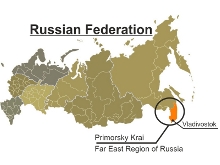Primorsky Krai — a Federal Subject of Russia
Primorsky Krai, informally known as Primorye, is a federal subject of Russia (a krai). Primorsky means "maritime" in Russian, hence the region is sometimes referred to as Maritime Province or Maritime Territory. Its administrative center is in the city of Vladivostok.
Today Primorsky Krai is the largest economy in the Russian Far East and is home to almost 2.1 million people, 89.89% Russian, 4.54% Ukrainian, and 0.86% Korean.
Geography

- Borders length — over 3,000 kilometres (1,900 mi), including 1,350 kilometres (840 mi) of the sea borders.
- Highest peak — Anik Mountain, 1,933 metres (6,342 ft)
- Railroads length — 1,628 kilometres (1,012 mi) (of which 345 kilometres (214 mi) are electrified).
- Automobile roads length — 12,633 kilometres (7,850 mi)
Primorsky Krai, bordered by China, North Korea, and the relatively warm - though freezing in winter – waters of the Sea of Japan, is the southeasternmost region of Russia.
There are many karst caves in the South of Primorye. The relatively accessible Spyashchaya Krasavitsa cave (the Sleeping Beauty) in the Ussuriysky Nature Preserve could be recommended for tourists. There are comparatively well-preserved fragments of the ancient volcanoes in the area. The ranges are cut by the picturesque narrow and deep valleys of the rivers and by large brooks.
The geographic location of Primorye accounts for the variety of its flora - there are mountainous tundra areas, conifers and coniferous-deciduous forests, and forest-steppe, which is sometimes called the Far Eastern Prairie, where many ancient plant species have been preserved, including ferns, lotus, and the Chosenia willow. The fauna of Primorye is also diverse.
History
.In the period from 1859 to 1882 ninety-five settlements were established in the Primorye region.
After the Russian Revolution, Primorskaya Oblast was replaced by the Far-Eastern Republic (1920-1922). Within the Russian SFSR, this became Far-Eastern Oblast (1922-1926) and then Far-Eastern Krai (1926-1938).
Primorsky Krai was formed by further subdivision of Far-Eastern Krai in 1938, as part of the Stalin era policy of "unbundling". Primorsky Krai, as defined in 1938, corresponds to the northeastern part of the historical region of Outer Manchuria.
The 1970s witnessed an expansion of scientific institutions in Primorye, especially in the city of Vladivostok. As a result the city possess several large research institutions such as the Institute of Biology and Agriculture, The Pacific Institute of Bio-organic Chemistry, The Institute of Marine Biology, The Pacific Institute of Geography, The Pacific Oceanological Institute, as well as several Institutes affiliated with the Far Eastern Division of the Russian Academy of Science
Economy
Primorsky Krai's economy, the most balanced in the Russian Far East, is also the largest in absolute terms.
The Krai's proximity to Pacific Rim markets gives it an edge over most other Russian Far East administrative divisions in developing foreign trade. Major trade items are seafood products, timber products, and ferrous metals. Major trading partners are Japan, China, and Korea.
| Federal district | Far Eastern |
| Established | October 20, 1938 |
| Administrative center | Vladivostok |
| Area (as of the 2002 Census) | Total 165 900 km2 (64,054.3 sq mi) |
| Population (2010 Census) | Total 1 956 497 |
| • Density | 1.79 /km2 (30.5 /sq mi) |
| • Urban | 76.1% |
| • Rural | 23.9% |
| Official languages | Russian |








